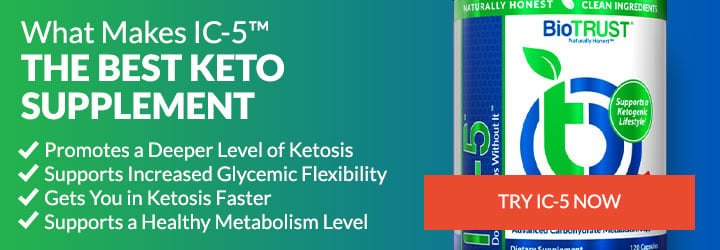6 Reasons Why Bacon is GOOD For You (Myths Debunked)

Mmm…everybody loves bacon—and I mean EVERYBODY. I’m pretty sure it was my daughter’s second-favorite food—by the time she was 16 months old (shhh…don’t tell my wife). Often duplicated, NEVER replicated, bacon is synonymous with breakfast; however, with its perfect combination of sweet, salty, and crispy, bacon is a “mealtime hero” morning, noon, and night.
The truth is that there’s quite a bit of confusion when it comes to bacon, and while the bacon fan club isn’t hurting for members, there are many who are outspoken about how “bad” and “unhealthy” it is. But what does bacon really do to your body? Is bacon good for you? Say it IS so!
Let’s clear through the confusion and tackle some of the myths, presumptions, and facts about this delicious meat candy.
Bacon is Good For You: 6 Health Benefits of Bacon
Believe it or not, bacon has many redeeming qualities beyond just tasting and smelling awesome. In fact, when you start to look a little deeper (and forget about what you’ve heard), you’ll realize that bacon is good for you—at least when it’s consumed as part of an overall healthy diet. Here are some of the things you should know about bacon.
1. Bacon is not just empty calories.
Believe it or not, bacon is not just a vehicle for empty calories. Now, let’s not stretch that to say that bacon is the next “superfood,” but surprisingly, bacon is good for you because it’s fairly nutritious. Two slices of pan-fried bacon, for instance, provide:
- 108 calories
- 8 grams of fat
- 8 grams of protein
- 0 carbs
- 0 sugar
- 387 mg of sodium
- 115 mg of potassium
On top of that, bacon contains several B vitamins (B1, B2, B3, B5, B6, and B12), selenium, phosphorus, iron, magnesium, and zinc. Obviously, most people’s eyes are drawn to sodium, which we’ll touch on more in just a moment, but there’s quite a bit more to bacon.
2. Bacon contains “healthy” fats.
Even though we’re collectively coming out of the rut that fat isn’t as bad as we’d been brainwashed to believe, most people still cringe when they see saturated fat—something many think is synonymous with bacon. In reality, saturated fat accounts for about 35% of the fat in bacon. However, what many people don’t realize is that about 45% of the fat in bacon is monounsaturated.
In fact, virtually all of the monounsaturated fat in bacon is oleic acid, which is the same “heart healthy” fat found in olive oil. This has led some to refer to bacon as “the new olive oil.” And while that’s said somewhat tongue-in-cheek, oleic acid has been shown to increase HDL (“good”) cholesterol, lower LDL (“bad”) cholesterol, promote skin healing, and support healthy levels of inflammation.1
The rest of the fat in bacon (about 10 – 15%) is polyunsaturated omega-3 and omega-6 fats. And just like other animals, what the pigs are fed has a heavy influence on the balance of these fats. If you want bacon that is good for you, it’s a good idea to reach for bacon from organic, pastured pigs, which contains significantly more omega-3s and yields a healthier omega-6 to omega-3 ratio.2
3. Bacon is a good source of high-quality protein.
With 30% of calories coming from protein, bacon isn’t the most protein-dense food. However, it is a good source of high-quality protein, which means it contains a good balance of amino acids (including all the essential amino acids), and the protein is highly digestible. In other words, bacon is good for you because it fits in well as part of a higher protein diet, which offers many benefits.
4. Bacon is really satisfying.
As part of a higher-protein diet, bacon can help improve appetite and craving management, and ultimately, with controlling caloric intake. Even though studies show that dietary fat isn’t all that satiating (which refers to the biological processes that are responsible for ending a meal), fat does seem to have a powerful effect on satiety (i.e., increasing feelings of fullness and satisfaction) by stimulating the release of appetite hormones.3 So, next time you ask “Is bacon good for you?” remember it can help you feel full and satisfied longer between meals.
5. Bacon is Paleo- and Keto-friendly.
If you want to get a fairly biased opinion on whether bacon is good for you, just ask folks who eat Paleo and Keto, two of the most popular diets where bacon is a figurative spokesperson. While there’s a decent amount of fanfare surrounding these diets, the fact of the matter is that there’s good evidence that Paleo and Keto may offer quite a few health benefits for a wide range of folks.
Let’s take the Paleo diet, for example:4–6
- It consistently ranks high for overall diet quality.
- It is inversely associated with all-cause and cause-specific mortality. In other words, the Paleo diet seems to reduce the risk of death, including death from cancer and heart disease.
- It is associated with lower levels of systemic inflammation and oxidative stress.
- It may help reduce body weight and waist circumference (belly fat).
- It may help improve blood pressure, blood sugar levels, triglycerides, and blood cholesterol.
How about Keto? Glad you asked. Here are some of the benefits associated with the ketogenic diet:7
- Weight loss
- Glycemic control
- Brain health and cognitive function
- Heart health
- Healthy aging
- Endurance performance
- And more!
6. Bacon makes everything better—including diet quality.
Bacon is a mealtime hero. It’s downright tasty, and part of the reason bacon is good for you is because it makes pretty much everything (including veggies) better. For example, when you think about bacon, what comes to mind? Eggs, right? After all, bacon and eggs are eaten together 70% of the time, and when it comes to nutrient density, eggs (including the yolks) are jam-packed.

So, Is Bacon Good For You (overall)? 5 Bacon Myths Debunked
How in the world is bacon good for you considering it contains saturated fat, cholesterol, sodium, and nitrates? After all, these things have been demonized over the years, and bacon must be guilty by association. There’s no possible way bacon is good for you, right? Not so fast. Let’s peel back the layers of some of the common nutritional myths and presumptions to see if bacon is really as unhealthy as we’ve been led to believe.
1. What about saturated fat?
Research back in the 1940s and 50s suggested a strong correlation between diets high in saturated fat and increased risk of heart disease, leading to the low-fat ideology and “diet-heart hypothesis.” Despite the compelling connections, the diet-heart hypothesis has come under great scrutiny of late and been largely dismissed.8
In other words, it’s now widely accepted that saturated fat is not associated with heart-related issues and other adverse health outcomes.9 On top of that, saturated fat is also very effective at raising HDL (“good”) cholesterol, and higher levels of HDL are associated with better heart health. Keep in mind that we’re not advocating a diet that relies only on bacon. Rather, we’re suggesting that bacon is good for you when it’s included as part of an overall healthy diet.
2. What about cholesterol?
Despite what you’ve been told, dietary cholesterol has virtually no impact on blood cholesterol. Even America’s ultra-conservative nutrition advisory panel, the Dietary Guidelines Advisory Committee (DGAC), recently stated, “Available evidence shows no appreciable relationship between consumption of dietary cholesterol and [blood] cholesterol.”
In fact, the DGAC retracted its previous recommendation to limit cholesterol to 300 mg/day because, “Cholesterol is not considered a nutrient of concern for overconsumption.” It’s about time America got out of this archaic way of thinking and joined the ranks of European countries, Australia, Canada, New Zealand, Korea, India, and others, which do not have an upper limit for cholesterol intake in their dietary guidelines.10
In other words, if you didn’t think bacon is good for you because it contains cholesterol, think again. You don’t need to worry about the cholesterol in your food, including bacon.
3. What about sodium?
There’s no question that bacon contains sodium. After all, salt (which contains sodium) is an intricate part of the curing process. Heck, one could argue that bacon is good for you because it’s such a good source of sodium, which is an essential nutrient that controls blood pressure and is needed to make nerves and muscles work properly. Sodium serves several key functions in the body:
- Assists in the absorption of chloride, amino acids, glucose, and water.
- Regulates extracellular fluid status, blood volume, and blood pressure.
- Maintains the electrochemical gradient across cell membranes, and tight regulation of this is critical for nerve impulse transmission, cardiac function, and muscle contraction.
When it comes to sodium, the evidence points to a U-shaped curve relating to the risk association of dietary sodium with heart disease and death from all causes. In other words, too little and too much sodium could be harmful. And in my experience, most people who are both physically active and are eating mostly whole foods need to increase the amount of sodium in their diets.
Currently, dietary guidelines suggest a maximum of 2,300 mg of sodium per day, or about one teaspoon of salt. While the average person consumes about 3,600 mg of sodium (mostly the result of eating packaged foods), there is insufficient evidence that lowering sodium intake to 2,300 mg per day either harms or improves cardiovascular outcomes. In fact, low sodium intakes may lead to a greater risk of adverse outcomes in certain populations.
According to Dr. Brian Strom, professor of public health and preventive medicine at the University of Pennsylvania School of Medicine in Philadelphia, “Changes in diet are more complex than simply changing a single mineral,” providing further support that improving overall nutrition quality is key to optimizing health and body composition.
According to researcher Eoin O’Brien, “It should come as no surprise that a low-salt-for-all policy would benefit some and disadvantage others.” Essentially, 90% of the world’s population “need no longer worry about whether their sodium intake poses a health threat” since they have a sodium intake within the optimum range (2.5 – 5 g).11
4. What about nitrates?
Okay, so the saturated fat, cholesterol, and sodium myths have been put to rest, but what about nitrates (and nitrites)? Surely, they’re a problem and a reason that there’s no possible way bacon is good for you, right? Maybe not.
Nitrates are important for flavoring and coloring bacon, and they also are very effective at inhibiting the growth of bacterial toxins (Clostridium botulinum). Nitrates are also naturally occurring in foods like beets and celery, and said nitrates have been shown to increase nitric oxide production, vasodilation, and blood flow. Consequently, they may improve blood pressure and exercise performance.
No, we’re not saying bacon is good for you because of the added nitrates. Rather, we’re just trying to provide a balanced view. Oh, and by the way, there’s no such thing as nitrate-free bacon—just uncured bacon that’s free from artificial nitrates and instead contains naturally-occurring nitrates (usually from celery extract).
But there’s no way bacon is good for you since nitrates cause cancer, right?
Believe it or not, the original research that connected nitrates to cancer has been the subject of tremendous scrutiny, and multiple massive scientific reviews have found no link between nitrates (or nitrites) and cancer. Surprising to many, the majority of nitrate/nitrites found in the body come from your own production of it—not food. For instance, 70 – 90% of the nitrite in the body can be found in your saliva.12
There are some concerns that during the cooking process, the nitrates found in bacon can turn into nitrosamines, which are known carcinogens (in test animals). USDA researchers have shown that “the addition of vitamin C and vitamin E reduced levels of nitrosamines in fried bacon and in nitrite-cured products.” As a result, the USDA now requires that these antioxidants be added to bacon during the curing process, a step that greatly reduces the amount of nitrite and the formation of nitrosamines.
Also, one bacon-cooking study showed “no evidence of nitrosamines in bacon fried at 210 °F for 10 minutes (raw), 210 °F for 15 minutes (medium well), 275 °F for 10 minutes (very light), or 275 °F for 30 minutes (medium well). But when bacon was fried at 350 °F for 6 minutes (medium well), 400 °F for 4 minutes (medium well), or 400 °F for 10 minutes (burned), some nitrosamines were found.” Thus, well-done or burned bacon is potentially more hazardous than less well-done bacon. Also, bacon cooked by a microwave has less nitrosamine than fried bacon.13
5. C’mon, how can you say bacon is good for you since it’s a processed meat? Aren’t processed meats linked to cancer, heart disease, third eyes, and everything else bad you can imagine?
There’s no question that ultra-refined “foods”—the hallmark of the typical Western-style diet—are associated with a laundry list of negative health outcomes. We’re talking junk foods, fast foods, and convenient store-bought packaged foods. However, processed meat, including bacon, may be a different story.
As a bit of background, processed meat is typically defined as products usually made of red meat that are cured, salted, or smoked (e.g., ham, bacon) to improve the durability of the food and/or to improve the color and taste. Generally speaking, high consumption of processed meat often leads to an increased intake of saturated fats, cholesterol, salt, and nitrates, which we’ve already discussed.
Several large observational studies have shown that high consumption of processed red meat is related to increased overall and cause-specific mortality (which is a fancy way of saying “death”). Ergo, people conclude that processed meat (such as bacon) causes cancer, heart disease, and ultimately, death.
Seems rational, but when you dig deeper, there are some serious confounding variables. For instance, “processed meat” is a much larger umbrella term than you might imagine. It often encompasses fast foods, such as pizza, bacon cheeseburgers, and hot dogs.
On top of that, folks with low overall processed meat consumption typically have a healthier lifestyle. On the flipside, people who eat more processed meat are less likely to be physically active, and they are more likely to be smokers, drink alcohol, and be obese. Folks who eat more processed meat typically eat fewer whole grains, fruits, and vegetables.14
Not a single study has isolated bacon as the culprit, and there’s tremendous doubt that processed meat itself is the real villain, especially when viewed in the context of lifestyle in general. Simply put, bacon is good for you when you eat it as part of an overall healthy diet (made up of predominantly whole, minimally processed REAL foods) combined with an exercise program and regular physical activity. More likely, if you eat some bacon as part of an overall crappy diet and sedentary lifestyle, it’s likely to be guilty by association.
How to Choose the BEST Bacon
When it comes to choosing bacon, here are some key things keep in mind to make sure bacon is good for you:
- Choose bacon from organic, pastured, humanely-raised pigs, which are fed a healthier diet and are not treated with synthetic growth hormones or antibiotics.
- Uncured bacon may sound/seem healthier, but it doesn’t appear to offer an advantage.
- Look for bacon with minimal additives, such as no added sugar, gluten, MSG, lactose, etc.
- Look for bacon with a high-protein density (around 30% or so) and a good protein to fat ratio (1:1 or better).
- Cook your bacon carefully as to avoid burning and over-cooking.
- Consume bacon as part of an overall healthy lifestyle, including a diet that emphasizes whole, nutrient-dense, antioxidant-rich foods and regular physical activity.
- Most of all, ENJOY your bacon!
And next time you hear someone ask “Is Bacon Good For You?”, tell them a resounding yes (in moderation).








